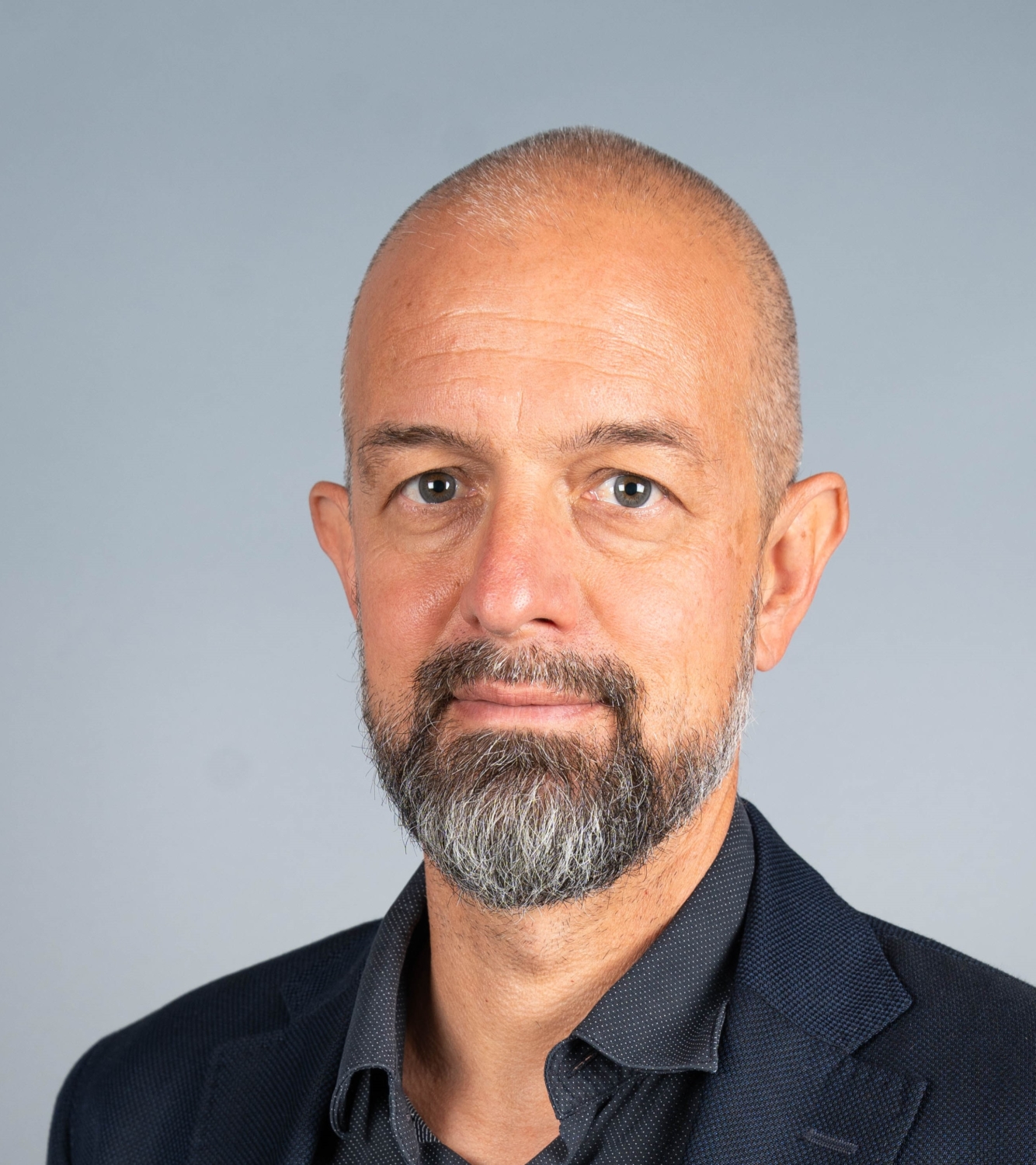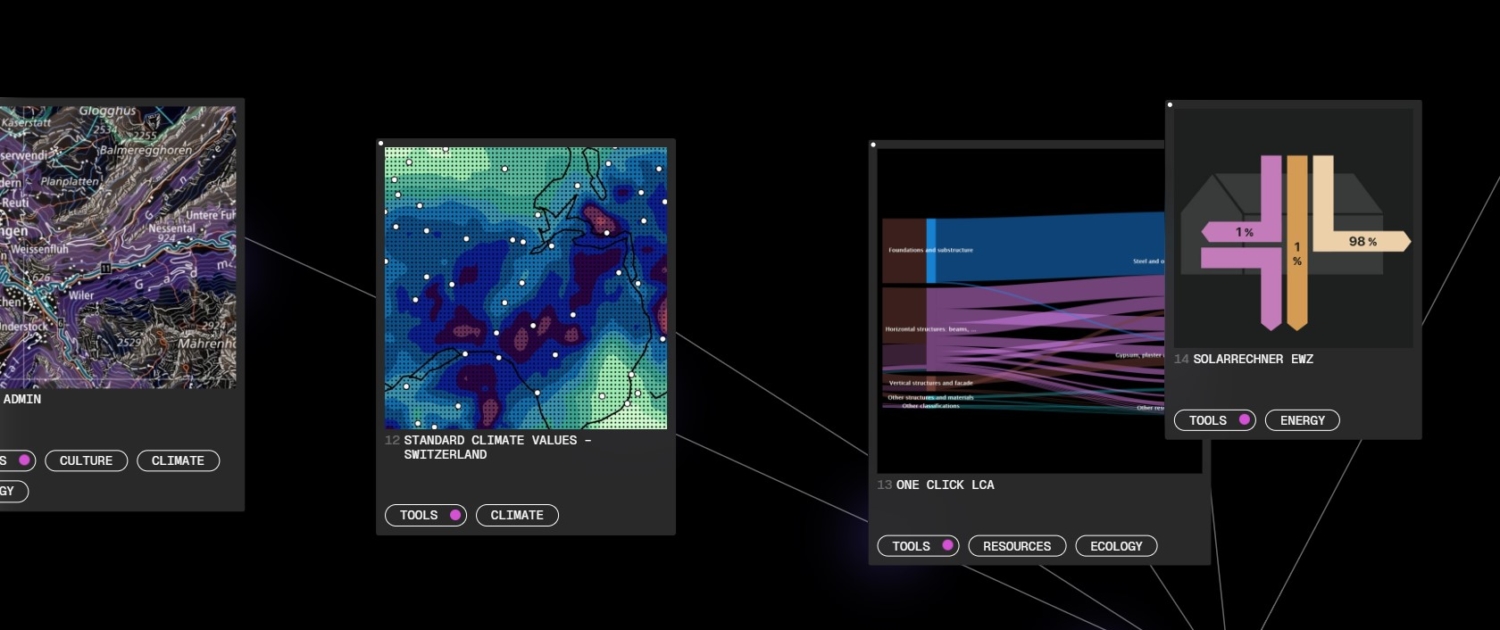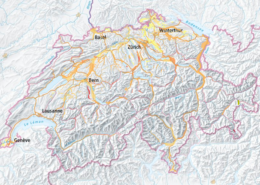New interactive platform in the field of architecture: for more sustainability in teaching and practice
The construction industry accounts for a significant proportion of Switzerland's resource and energy consumption and greenhouse gas emissions. If Switzerland wants to achieve the net-zero target by 2050, the construction industry must consistently focus its processes, materials and technologies on the circular economy, energy efficiency and climate-friendly solutions. How do you plan and build in such a way that as few resources and energy as possible are consumed and greenhouse gases are emitted?
On the new interactive IDA platform, planners and architects in training and from the field can find an overview of standards, as well as tools and best practice examples to achieve this goal. The development of the platform was supported by SwissEnergy, the Swiss Federal Office of Energy's program for energy efficiency and renewable energies.
IDA stands for Integrated Design Atlas. The digital platform is intended as an interactive learning environment that makes knowledge about ecologically and socially sustainable construction accessible. The topics covered include renewable energies and the circular economy, as well as tools such as the heating cost or solar calculator, platforms for calculating sustainability and relevant geoinformation. The platform is supplemented by examples of best practice and information on events. A community will also be able to form via the platform, thereby promoting exchange and networking between architecture schools and the transfer of knowledge into practice.
Why is this platform needed? What do you hope to gain from it? Why has SwissEnergy become involved in this project? Energeiaplus asked Samuel Kummer, assistant at the Department of Architecture at ETH Zurich and project coordinator of IDA, and Christoph Blaser, responsible for education and training at the Swiss Federal Office of Energy.
Energeiaplus: The IDA platform brings together information that is already available. What added value does IDA offer?

Samuel Kummer is project coordinator of the IDA platform; image ETHZ
Samuel Kummer: "The platform pools findings from research and teaching at leading Swiss universities and supports users in making sustainable decisions in the early design phases. In addition to the pure transfer of knowledge with IDA, it is also very important to us to facilitate the exchange between educational institutions, practitioners and students and thus promote networked learning across institutions and language regions.
Who is the platform for?
Samuel Kummer: IDA is basically open to all interested parties, but is primarily aimed at students, teachers and architects. We draw students' attention to the platform in our courses. Teachers are specifically approached via networks and personal contacts in order to integrate the platform into their courses and promote the exchange of best practice examples. We reach architects via social media posts, presentations at specialist events and collaborations with organizations such as the SIA.
Where is there a lack of education and training for planners and architects?
Samuel Kummer: The integration of energy and climate perspectives is often neglected in the design process. Functional and social aspects are established, but the complex interrelationships between energy, comfort and the environment are usually ignored in the early project phase. This is precisely where IDA comes in: We turn climate, emissions and other issues relevant to sustainability into integral components of architecture - not as an add-on, but as a foundation. In this way, today's challenges become inspiration for sustainable construction and enable architects to develop holistically sustainable solutions from the outset.
Christoph Blaser: In 2023, the Federal Office for the Environment commissioned a study to investigate how ecologically sustainable construction is addressed in the training and further education of planners. It came to the conclusion that there is potential to formulate sustainability skills more explicitly in various courses of study. My impression is that architects often have a keen sense of the levers of sustainability. However, in the design phase, they often lack the ability to objectively assess the impact of their decisions on the various sustainability aspects of a project. This is where IDA's numerous tools offer valuable support in order to optimize their projects in a targeted manner at an early design stage and to check the interactions between the individual sustainability levers.
At first glance, IDA may appear somewhat complex. Various tiles with images or graphics appear on the screen. If you click on the tiles, you are redirected to the website with the relevant information. What are the considerations behind the design of the platform and how does it support the discovery of the content?
Samuel Kummer: A graphically designed landing page was developed to make it attractive for architects and students to get started with IDA. It complements the Moodle-based platform, which has limited scope for design, and deliberately invites users to discover the content in a playful and interactive way. The four main areas are clearly presented so that users can find their way around and quickly understand what content is available.
The content has been put together in a targeted manner and the links between them visualized so that connections are easily recognizable. IDA is divided into four sections. The case studies present "good practice" projects with plans, images and descriptions. In the Toolbox, users will find digital tools that they can use directly in the design process. Stories provide in-depth contributions to the case studies and tools, while the Community enables professional exchange, discussions and information on events.
SwissEnergy supported the development of the platform. Why?

Christoph Blaser is a specialist in education and training at the Swiss Federal Office of Energy; Image: SFOE
Christoph Blaser: The project was submitted to and funded by SwissEnergy as part of the Buildings Education Offensive (BOG). The BOG is a joint initiative of the building sector, educational institutions and the federal government to ensure a sufficient number of qualified specialists for the implementation of the energy and climate strategy in the building sector.
With the BOG, we are promoting, among other things, the anchoring of energy and environmental skills in formal education as well as cooperation within the sector. The new interactive platform significantly supports both objectives. Architects have a decisive influence on the sustainability of buildings with their skills and decisions. This target group is also significant in terms of numbers: In Switzerland, around 1,000 students complete a Bachelor's or Master's degree in architecture every year.
What does the federal government expect from the platform? A collection of information and examples of best practice is not enough to achieve sustainable, resource-conserving and energy-efficient construction.
Christoph Blaser: The platform helps to accelerate education and training in the field of energy-efficient and sustainable building planning. As the name suggests, the Integrated Design Atlas promotes an integrated approach that places the principles of renewable energy and energy efficiency, sustainable resources and climate protection at the heart of the early design phases.
IDA provides an overview of digital tools that support early consideration of the relevant sustainability factors. This is in light of the fact that the early project phases offer the greatest scope for targeted control of a building's sustainability.
The use of the knowledge and design platform by nine architecture schools and the members of the SIA also promotes exchange and collaboration between architecture schools and current and future architects. At the same time, it prevents similar isolated solutions being developed independently of each other at different locations.
The platform helps to ensure that holistic, ecologically sustainable construction becomes the norm and is seen by all architects as a natural part of their work.
What developments or expansions are planned for the coming years?
Samuel Kummer: IDA has been set up over three years. In the first year, the technical infrastructure was created and the content of the existing Moodle platform was transferred and selectively expanded. Since the start of the second year, the focus has been on community-building activities such as forums, webinars and user meetings. This will strengthen active use, ensure ongoing maintenance and continuously integrate new content in the areas of toolbox, case studies, stories and community.
The aim is for IDA to become an integral part of teaching at Swiss architecture schools. In the third year, long-term management and scaling will be ensured by the partners and other sponsors. At the same time, architects are to be more closely involved in practice and motivated to actively participate and make their own contributions.
The platform was developed together with nine project partners, including eight universities from all language regions and the Swiss Society of Engineers and Architects (SIA). SwissEnergy supported the project.
Project partners:
Bern University of Applied Sciences (BFH)
Swiss Federal Institute of Technology Zurich (ETH Zurich)
University of Applied Sciences Northwestern Switzerland (FHNW)
Haute école d'ingénierie et d'architecture de Fribourg (HEIA-FR)
Lucerne University of Applied Sciences and Arts (HSLU)
University of Applied Sciences of Eastern Switzerland (OST)
Swiss Society of Engineers and Architects (SIA)
Scuola universitaria professionale della Svizzera italiana (SUPSI)
Università della Svizzera italiana (USI)
Zurich University of Applied Sciences (ZHAW)
Interview: Brigitte Mader, Communications, Swiss Federal Office of Energy
 Screenshot IDA
Screenshot IDA
 Energie Zukunft SchweizNew Energy Investor Summit am 20. Mai 2019
Energie Zukunft SchweizNew Energy Investor Summit am 20. Mai 2019  Swisstopo - GeoinformationNeue Studie: Das Grundwasser zu energetischen Zwecken optimal nutzen
Swisstopo - GeoinformationNeue Studie: Das Grundwasser zu energetischen Zwecken optimal nutzen  Stockfotos-MGLiebes BFE: Wohin fliesst das Geld der CO2-Abgabe?
Stockfotos-MGLiebes BFE: Wohin fliesst das Geld der CO2-Abgabe?  ©Etat de GenèveÀ la recherche des ressources géothermiques du sous-sol suisse
©Etat de GenèveÀ la recherche des ressources géothermiques du sous-sol suisse 
 OFEN
OFEN Genossenschaft Mobility
Genossenschaft Mobility
Neuste Kommentare